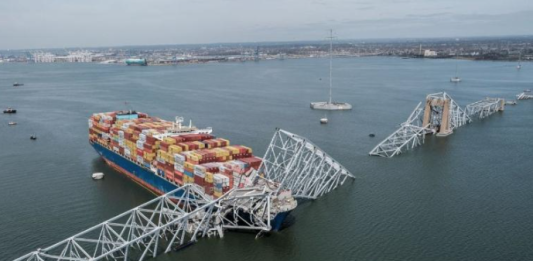
Clean-up operation going to start in Baltimore due to the Francis Scott Key Bridge collapse
BALTIMORE : US Navy engineers have sent two cranes mounted on barges to begin the clear-up operation following the collision of the Maersk-operated MV Dali and the Francis Scott Key Bridge in Baltimore, causing the bridge to collapse.
Maryland Governor Wes Moore said one of the cranes can lift up to 1,000 tonnes and will be one of at least two used to clear the channel of the metal and concrete remains of the bridge.
Meanwhile, the Maryland Government has established that there are 56 hazardous containers on board the 10,000 TEU vessel and that 14 of these boxes were damaged as the bridge collapsed.
As a result, the Unified Command, which is coordinating operations, said yesterday (28 March) that dive and vehicle recovery operations have stopped due to hazardous conditions caused by the submerged wreckage and debris.
In addition, authorities have established a 1,800m safety zone around the Dali for the protection of personnel, vessels, and the marine environment from the potential hazards associated with salvage work.
“On-scene crews continue to assess and monitor for spilled oils and hazardous substances to prevent further discharge or release into the marine environment. There is 600m of sorbent boom deployed at the incident site, and 600m of hard containment boom with anchoring systems deployed around the vessel. Additionally, 300m of boom is on stand-by to deploy if additional prevention supplies are required,” said a Maryland Government statement.
The Unified Command is also addressing environmental concerns with response teams conducting visual inspections of water quality as well as collecting samples for testing.
Response teams have said there is a sheen around the vessel, and that the 14 damaged containers are being assessed by an industrial hygienist for potential hazards.
According to the authorities, the chemicals assessed were soap products, perfume products, “or not otherwise specified resin”.
“We have been conducting air monitoring on the vessel and around the vessel with our contractor. No volatile organic compounds or flammable vapours were observed. We are continuing to air monitor throughout the incident,” reported the response team.
Meanwhile, the White House’s National Economic Council convened to address supply chain disruptions caused by the Dali accident. The task force, which includes representatives from the departments of Transportation, Commerce, Agriculture, and Defense among others, discussed the potential impacts on regional and national supply chains.
A statement from the US White House said, “The Task Force will coordinate Federal outreach and efforts to assist impacted industries and will continue to monitor shipping activity at alternative ports as shipments are diverted. The Task Force is also monitoring the impact of the closure on the workers directly associated with activities at the Port of Baltimore and will work with the Department of Labor, the state of Maryland, and impacted employers and unions to minimise impacts.”
The Port of Baltimore is the ninth largest in the United States and handles an array of cargoes including automobiles, farm machinery, and agricultural products along with coal and gas.
